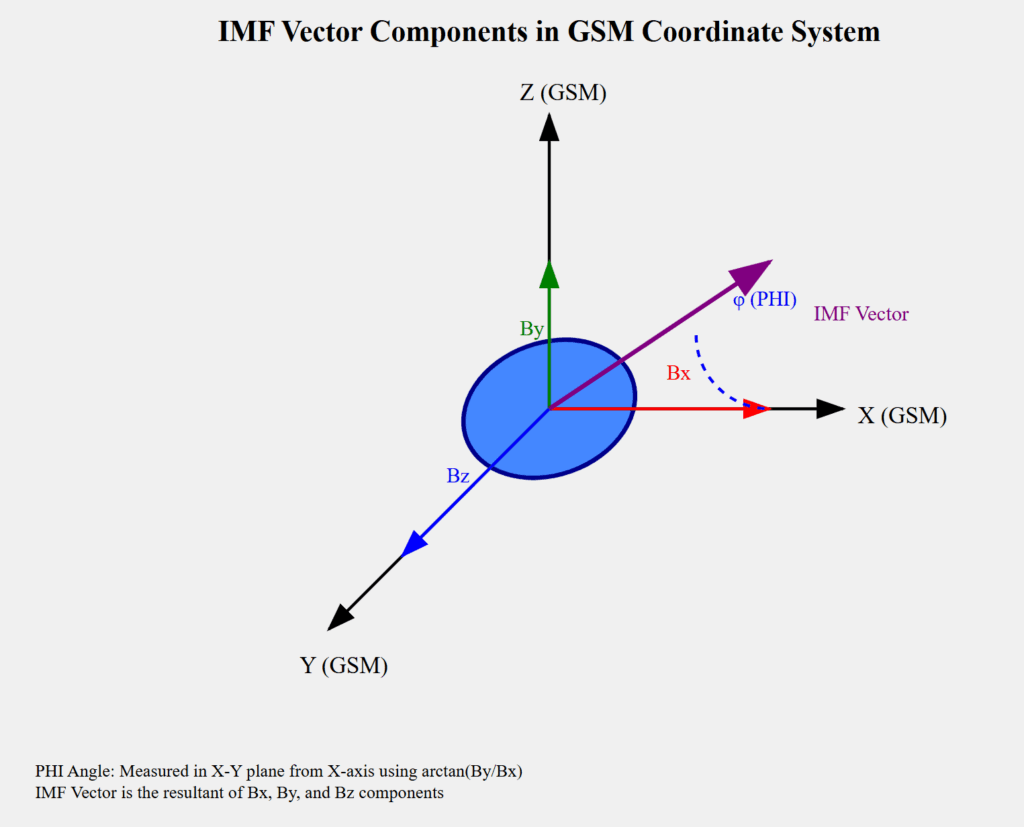Phi (ϕ) for the Ham: What It Really Means
Let’s clear up the mystery around the “phi angle” — no, it’s not your geographic latitude. In space weather, phi (ϕ) refers to the angle of the interplanetary magnetic field (IMF) — that’s the magnetic field carried by the solar wind from the Sun. And yes, it can mess with your HF signals below 30 MHz in a big way.
Wait… Phi Angle? Think of the Sun like a moody, magnetic transmitter. It’s constantly beaming out plasma and magnetic fields, but the direction of those fields — especially the phi angle — can determine how likely
they are to couple with Earth’s magnetic shield. When that coupling
is strong, geomagnetic storms ramp up, and your bands shut down.
So What Does Phi Tell a Ham?
The phi angle is measured in degrees (0°–360°) and describes which direction the solar magnetic field is pointing in the plane of Earth’s orbit. When it lines up just right (especially around 90° or 270°) — and if the Bz component is southward — it can inject energy into Earth’s magnetosphere. That means aurora, signal blackouts, and HF weirdness.
⚠️ This isn’t about your location on Earth — it’s about what direction the Sun’s magnetic field is pointing as it hits us.
But Your Latitude Does Matter Too
Now, let’s talk about your actual latitude — that is, how far north or south you are on Earth. That does influence how space weather affects your local HF conditions:
- If you’re at higher latitudes (Alaska, Scandinavia), you’re closer to the auroral zones. That means more frequent ionospheric absorption, particularly during geomagnetic storms.
- Lower latitudes often get better stability and more consistent MUF (Maximum Usable Frequency) during solar events — but aren’t immune.
Normal Days: Good Signals and Predictable Paths
On quiet solar days, the ionosphere behaves well. Your HF signals bounce predictably off the F-layer, and propagation is solid. Here, your latitude still matters — because the amount of solar radiation (i.e. sunlight) your ionosphere receives varies:
- More sun = more ionization = higher frequencies open
- Less sun = lower ionization = lower bands perform better
Solar Flares: The Static Hammer
Now picture this — the Sun throws a tantrum. A sudden burst of X-rays and extreme ultraviolet light reaches Earth within minutes. Here’s what happens:
⚡ Sudden Ionospheric Disturbances (SIDs)
Flares can instantly saturate the D-layer, especially on the daylight side of Earth. That means:
- Signals vanish without warning
- Absorption on 3–10 MHz bands spikes
- Even time signals and WWV may go quiet
⚠️ Increased HF Noise
Your receiver picks up more crackling and hiss across multiple bands. It’s not your gear — it’s the Sun raining chaos.
These flare effects are local-time dependent — they mostly hit the sunlit side of the Earth. So, if it’s noon for you when the flare hits… duck.
Summary
- ✅ Phi angle = orientation of the solar magnetic field — not your location
- ✅ Bz matters more, but phi hints at how conditions might play out
- ✅ Your latitude still influences how badly HF conditions are affected
- ✅ Solar flares are instant, brutal, and make 40m sound like a frying pan
Hold it! That’s it? No…. what about —
‘Bz Component (Critical)’
Description: ‘The Z-component of the Interplanetary Magnetic Field (IMF) in GSM coordinates. Measured in nanoteslas (nT). Bz points northward, perpendicular to the ecliptic plane.

This is the MOST critical component for ham radio operators.
When Bz is negative (southward), it can reconnect with Earth’s magnetic field, causing geomagnetic storms that disrupt HF propagation.’
Now, after a flare, or sometimes independently, the Sun can also hurl massive clouds of plasma and magnetic field our way – these are Coronal Mass Ejections (CMEs). While flares can give you a quick punch, CMEs can lead to longer-lasting and often more intense disruptions, and that’s where Bz becomes super important.
Think of Bz as the key that can unlock major HF disruptions when a CME arrives. Bz refers to the north-south direction of the magnetic field that’s carried by the solar wind and those big, magnetic CME clouds.
Imagine Earth has its own magnetic field acting like an invisible shield. When a CME arrives carrying its own magnetic field, the direction of that CME’s Bz component is absolutely crucial.
- If Bz is pointing north (positive): The CME’s magnetic field tends to slide past Earth’s magnetic field without causing too much fuss. You might see some minor wobbles in the ionosphere, but the big, HF-killing geomagnetic storms are less likely to fire up.
- If Bz is pointing south (negative): This is when things can get interesting (and often frustrating!) for us HF operators. A southward-pointing Bz can connect and tangle with Earth’s normal northward-pointing magnetic field. This connection acts like an open door, allowing a whole lot of the CME’s energy to flood into our magnetosphere, like opening a floodgate.
Why is a negative Bz reading so critical for ham radio communication below 30 MHz?
When Bz swings south and stays there for a while, it can lead to:
- Major Geomagnetic Storms: These storms really stir up the ionosphere, making HF propagation unpredictable. Signals can become weak, distorted, or even disappear entirely for hours or even days.
- Strong Auroras at Lower Latitudes: You might get to see the Northern or Southern Lights much further towards the equator than usual. While beautiful, this is a strong sign that charged particles are bombarding the upper atmosphere and likely disrupting HF signals, especially on paths going anywhere near the polar regions.
- Big Drops in the Maximum Usable Frequency (MUF): Those higher HF bands you often rely on for long-distance contacts can suddenly go quiet. You might find yourself needing to switch to much lower frequencies to have any chance of making a contact.
- Increased Signal Absorption: Even on the lower HF bands, signals can get absorbed more easily in the disturbed ionosphere, meaning weaker signals at the receiving station.
- Polar Paths Hit Hardest: If you frequently try to communicate over the North or South poles, geomagnetic storms triggered by a negative Bz can make these paths extremely difficult or even impossible.
Your Latitude Matters:
- Higher Latitudes: If you live closer to the North or South poles, you’re more likely to experience the dramatic effects of geomagnetic storms on your HF communications, like strong auroras and significant signal disruptions.
- Mid-Latitudes: You’ll still feel the effects of solar weather, including SIDs from flares and some degradation of HF propagation during geomagnetic storms, though perhaps not as intensely as those at higher latitudes.
- Lower Latitudes (closer to the equator): You’re generally less affected by the high-latitude phenomena like strong auroras. However, you’ll still experience SIDs from flares and some changes in ionospheric conditions during major geomagnetic storms.
Phi () for the scientist
The angle phi () in the context of solar geometry typically refers to the latitude of a location on Earth. Latitude is a crucial factor influencing various solar phenomena, though it doesn’t directly describe the dynamic events we call “solar weather.” Let’s break this down:
Phi () as Latitude in Solar Geometry:
- In solar geometry, represents the geographical latitude, which is the angle north or south of the Earth’s equator. It’s a fixed property of a location.
- Latitude plays a fundamental role in determining the amount and intensity of solar radiation received at a specific location throughout the year.
 This is because latitude affects:
This is because latitude affects:- Solar Zenith Angle: The angle between the sun’s rays and the vertical. Latitude is a key component in calculating this angle, which dictates the path length of sunlight through the atmosphere and the concentration of energy on the surface. A lower zenith angle (sun more directly overhead) means more intense radiation.
- Day Length: Higher latitudes experience greater variations in day length throughout the year due to the Earth’s tilt. This impacts the total solar energy received daily.
- Seasonal Variations: The change in the Earth’s orientation relative to the sun throughout the year causes seasons. The effect of these seasons on solar radiation is more pronounced at higher latitudes.
 Mathematically, the solar zenith angle () can be related to latitude (), solar declination (), and the hour angle () by the following equation:
Mathematically, the solar zenith angle () can be related to latitude (), solar declination (), and the hour angle () by the following equation:
Solar Weather:
Solar weather, on the other hand, refers to the dynamic and energetic phenomena originating from the Sun that can affect Earth’s magnetosphere, ionosphere, and thermosphere. These include:
- Solar Flares: Sudden bursts of electromagnetic radiation and energetic particles.
- Coronal Mass Ejections (CMEs): Large expulsions of plasma and magnetic field from the Sun’s corona.
- Solar Wind: A continuous stream of charged particles flowing from the Sun.
- Coronal Holes: Regions in the Sun’s corona with open magnetic field lines, allowing high-speed solar wind streams to escape.
In Summary:
The phi angle () in solar geometry represents latitude, a static geographical coordinate that significantly influences the amount and intensity of solar radiation received at a location. While latitude doesn’t directly cause solar weather events, it plays a role in how Earth’s atmosphere and magnetic field interact with and respond to these dynamic solar phenomena, leading to latitudinal variations in their effects, such as auroras and geomagnetic storms.
How Latitude Relates (Indirectly) to the Effects of Solar Weather:
While latitude itself doesn’t cause solar weather events, it influences how Earth responds to them:
- Auroras: These spectacular displays of light in the sky occur when charged particles from the solar wind or CMEs interact with Earth’s magnetic field and are funneled down to the polar regions (high latitudes). The latitude determines how frequently and intensely auroras are visible.
- Geomagnetic Storms: These disturbances in Earth’s magnetic field, caused by solar wind and CMEs, can induce currents in the ground, affecting power grids and pipelines, and disrupt radio communications and GPS systems. The effects can vary with latitude.
- Ionospheric Disturbances: Solar flares and CMEs can significantly impact the ionosphere, affecting radio wave propagation. These effects can have latitudinal dependence.
- Radiation Exposure: During strong solar events, increased levels of radiation can pose a risk to astronauts and high-altitude aircraft, particularly at higher latitudes where the magnetic field provides less shielding.
In a Nutshell for the Radio Ham
That phi angle (your latitude) puts you in a certain zone that reacts differently to the Sun’s tantrums (solar weather). Solar flares can cause quick blackouts, especially on lower bands during the day. CMEs can lead to longer periods of poor propagation, especially on higher bands, and can be particularly rough if you’re trying to work DX at higher latitudes or over the poles.
Keep an eye on your latitude for a general sense of what to expect from solar activity. Understand that solar flares can cause quick but often temporary disruptions.
And most importantly, pay close attention to the Bz reading in solar weather forecasts. A southward (negative) Bz, especially if it’s strong (a larger negative number) and lasts for several hours, is a big red flag that good HF conditions might be heading south, no matter where you are on the map.
Knowing the Bz direction and strength is often more crucial than just knowing that a CME is heading our way! This single parameter can be the difference between minor disruption and complete HF blackout. Solar weather forecasts can give you a heads-up when conditions might deteriorate rapidly.
Stay informed and happy DXing! (when the Sun cooperates)


